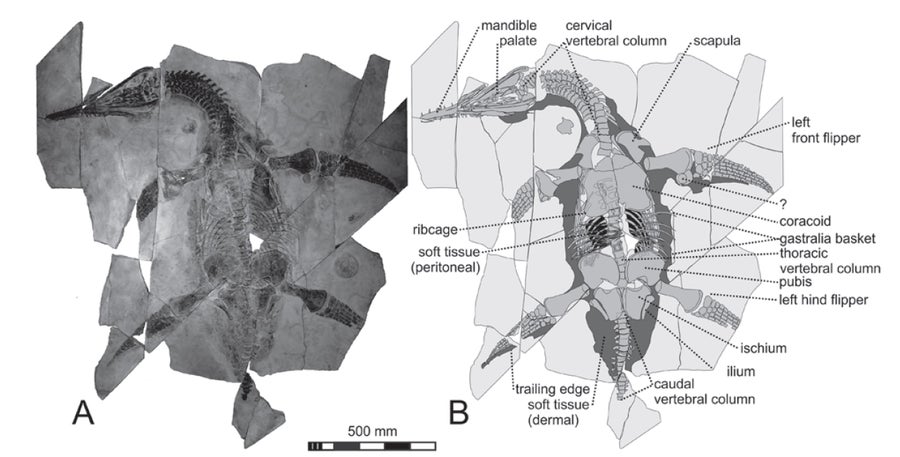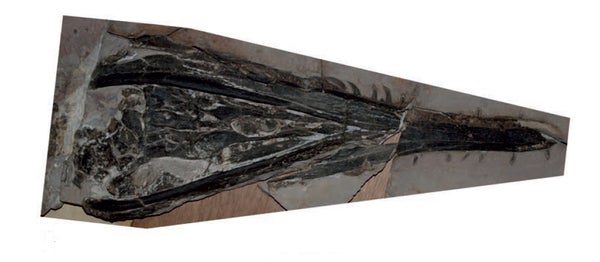This article was published in Scientific American’s former blog network and reflects the views of the author, not necessarily those of Scientific American
As far as prehistoric celebrities go, plesiosaurs are A-listers. No image of Mesozoic seas seems complete without these four-flippered reptiles in one of their various short- or long-necked forms. Despite their fame, however, we know relatively little about what these swimmers looked like beyond what can be gleaned from bones. There are beautiful pleiosaur skeletons, to be sure, but soft tissue impressions and traces are extremely rare. That's what makes a recent find from northeastern Mexico so wonderful.
The fossil, discovered in 2011 by limestone quarry workers, represents a new species of plesiosaur. Paleontologist Eberhard Frey and colleagues have called it Mauriciosaurus fernandezi in honor of the man who donated the 93 million-year-old reptile to science. The skeleton itself is beautiful, nestled up on itself in articulation, but it's the extensive soft tissues that make this reptile from America's vanished seaway so precious.
Fossilized remnants of the plesiosaur's soft tissues trail from the neck to the flippers, torso, and tail. Given that the only other example of preserved plesiosaur soft tissue recognized to date is part of a flipper edge from a Jurassic specimen from Germany, the preserved parts of Mauriciosaurus can offer some new clues about what plesiosaurs were like in life.
Not all the soft tissue remnants are preserved the same way. Frey and coauthors pick out five different types of soft tissue remnants around the skeleton. Some of it - such as "glossy black material" inside the body cavity - could be what's left of the intestines or a specialized membrane. Other portions might be what's left of skin or fat in different parts of the body. Overall, though, the petrified tatters reinforce that these reptiles had teardrop shaped bodies - thicker at the front and narrowing behind - with trailing edges along their flippers. Look at a leatherback sea turtle, Frey and coauthors suggest, and you have a rough idea of the Mauriciosaurus body layout.
Altogether, Frey and colleagues write, the soft tissue leftovers hint that this plesiosaur - and maybe many of these marine reptiles - had relatively thin skin with a thicker layer of fatty tissue underneath. This might account for why many excellent plesiosaur skeletons have been found, but soft tissue structures are rare. An unusual set of circumstances allowed a little bit more of Mauriciosaurus to enter the fossil record, and hopefully luck will lead paleontologists to similar finds in the future.

The skeleton of Mauriciosaurus fernandezi. Credit: Frey et al. 2017
On supporting science journalism
If you're enjoying this article, consider supporting our award-winning journalism by subscribing. By purchasing a subscription you are helping to ensure the future of impactful stories about the discoveries and ideas shaping our world today.
Fossil Facts
Name: Mauriciosaurus fernandezi
Meaning: This plesiosaur's name honors Mauricio Fernández Garza, who made the specimen available for study after its discovery in a limestone quarry.
Age: Cretaceous, around 93 million years ago.
Where in the world?: Vallecillo, Mexico.
What sort of critter?: A plesiosaur belonging to a group called polycotylids.
Size: About six feet long with a flipper span of nearly four feet.
How much of the organism’s body is known?: A nearly-complete, articulated skeleton.
Reference:
Frey, E., Mulder, E., Stinnesbeck, W., Rivera-Sylva, H., Padilla-Gutiérrez, J., González-González, A. 2017. A new polycotylid plesiosaur from the early Late Cretaceous of northeast Mexico. Boletín de la Sociedad Geológica Mexicana. 69 (1): 87-134
Previous Paleo Profiles:
The Light-Footed Lizard The Maoming Cat Knight’s Egyptian Bat The La Luna Snake The Rio do Rasto Tooth Bob Weir's Otter Egypt's Canine Beast The Vastan Mine Tapir Pangu's Wing The Dawn Megamouth The Genga Lizard The Micro Lion The Mystery Titanosaur The Echo Hunter The Lo Hueco Titan The Three-Branched Cicada The Monster of Minden The Pig-Footed Bandicoot Hayden's Rattlesnake Demon The Evasive Ostrich Seer The Paradoxical Mega Shark The Tiny Beardogs The Armored Fish King North America's Pangolin The Invisible-Tusked Elephant The Mud Dragon The Spike-Toothed Salmon The Dream Coast Crocodile Buriol's Robber Ozimek's Flyer The Northern Naustoceratopsian The High Arctic Flyer The Tomatillo From the End of the World The Short-Faced Hyena The Mighty Traveler from Egg Mountain Keilhau's Ichthyosaur Mexico's Ancient Horned Face
